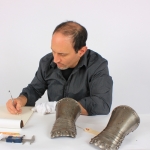No products in the cart.
 Recently, Eyal Azerad, the owner of Darksword Armory, took a first-hand examination of an authentic pair of 16th century German Gauntlets. The Gauntlets are dated from 1580-1590’s. Made of Iron. Rolled and roped edge cuffs, five slightly tapered and embossed metacarpal plates and shaped knuckle plates. Finely etched with continuous floral design on the central band and upper borders. These present one of the nicest pair of Gauntlets we have inspected in the last couple of years.
Recently, Eyal Azerad, the owner of Darksword Armory, took a first-hand examination of an authentic pair of 16th century German Gauntlets. The Gauntlets are dated from 1580-1590’s. Made of Iron. Rolled and roped edge cuffs, five slightly tapered and embossed metacarpal plates and shaped knuckle plates. Finely etched with continuous floral design on the central band and upper borders. These present one of the nicest pair of Gauntlets we have inspected in the last couple of years.
Interestingly enough, the floral designs etched on the German Gauntlets are almost identical to an Italian model of the same period (16th century). This close similarity points to a clear trend in fashion and artistic creativity during the end of the 15th century and extending well into the 16th. Similar floral patterns were not only found on leg armor, breastplates, gauntlets and helmets, but also on wax seals, woodcuts and architectural structures.
Previous to 1400 A.D. floral designs seems to have been limited to Persian paintings, rugs and tapestries of the fourteenth century. Armors of Medieval Europe seldom displayed similar trends in terms of design.
By the 15th Century, an artistic revival in Greek and Roman styles emerged. Blacksmiths began etching foliage on various parts of the armors. Olive vines, roses, ivies and laurels were often etched on breastplates, pauldrons and arm harness, descending to the gauntlets. This revival or revised interest in the arts began during the Trecento, a strong revival and interest in art, in all its
forms. Interest in painting, sculpting, music, and literacy were heightened and mutually influenced. At the core of the Trecento, was the return to the classical principle of composition and realism. Hence, the artistic trend examined in the Gauntlets can be explained in a much wider conceptual framework in which all aspects of art were influenced, not only in armor and sword making, but on an intellectual and humanist level.



